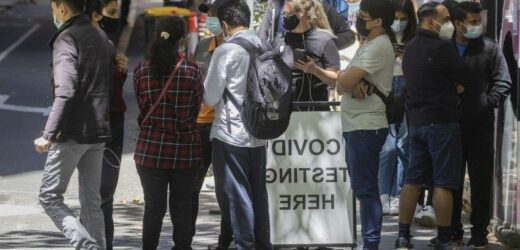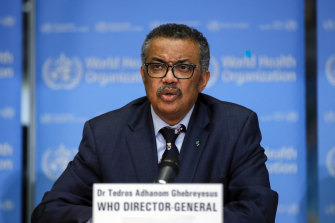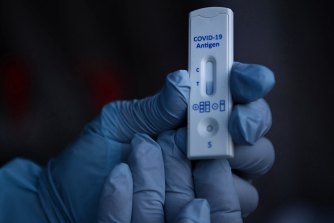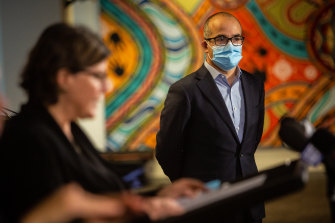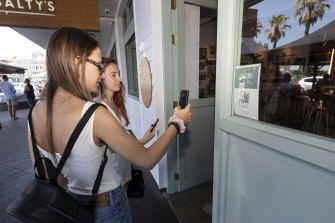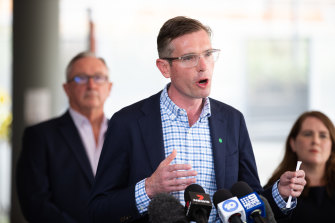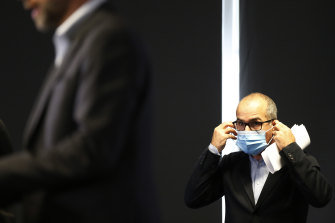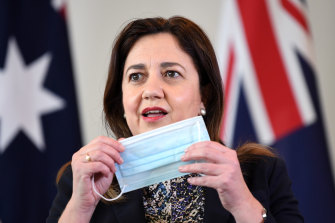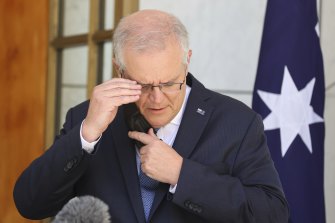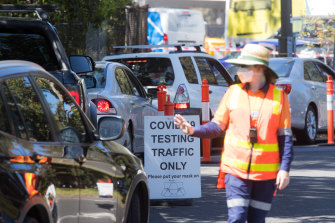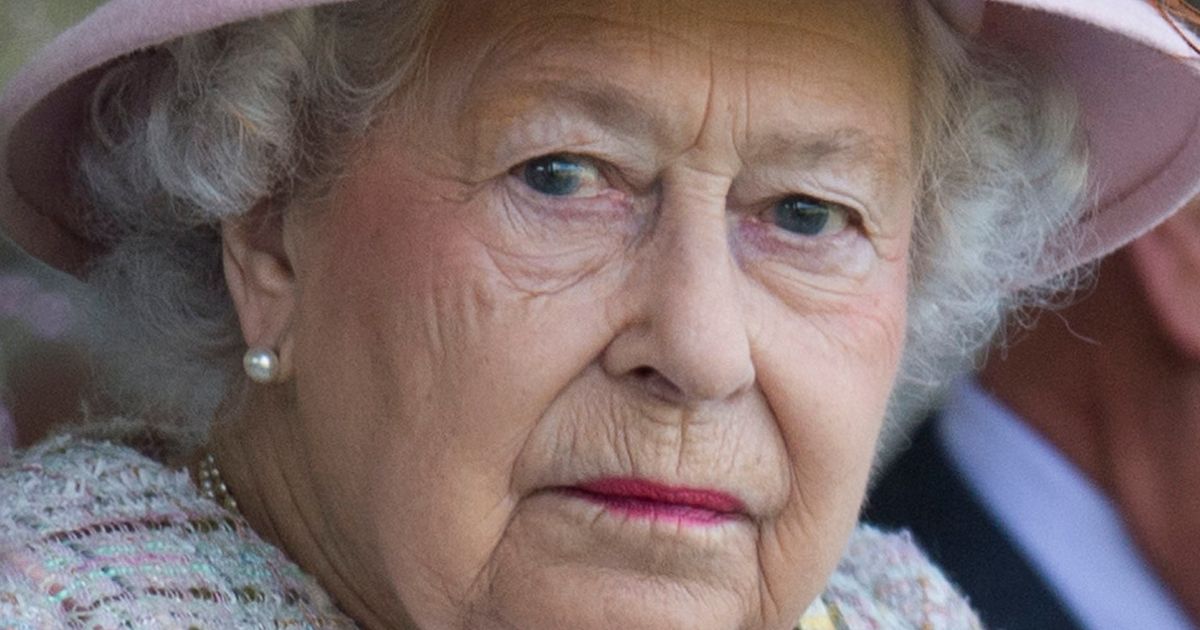Our live coverage of the coronavirus pandemic is free for all registered readers. Please also consider supporting our journalism with a subscription.
Key posts
- Blanket booster programs ‘likely to prolong pandemic,’ not shorten it: WHO Director-General
- Victorian government expected to outline changes to mask rules today
- More on the reintroduction of QR codes in NSW
- The morning’s headlines at a glance
1 of 1
Blanket booster programs ‘likely to prolong pandemic,’ not shorten it: WHO Director-General
As Australia considers whether to shorten the interval between second and third doses of coronavirus vaccines for adults, the World Health Organisation has warned blanket booster programs are likely to prolong the pandemic.
Dr Tedros Adhanom Ghebreyesus, Director-General of the World Health Organisation at WHO headquarters in Geneva.Credit:Bloomberg
WHO Director-General, Dr Tedros Adhanom Ghebreyesus, made the following observations at a media briefing yesterday:
About 20% of all vaccine doses administered every day are currently being given as boosters or additional doses.
Blanket booster programmes are likely to prolong the pandemic, rather than ending it, by diverting supply to countries that already have high levels of vaccination coverage, giving the virus more opportunity to spread and mutate.
It’s important to remember that the vast majority of hospitalisations and deaths are in unvaccinated people, not un-boosted people.
And we must be very clear that the vaccines we have remain effective against both the Delta and Omicron variants.
The global priority must be to support all countries to reach the 40% target as quickly as possible, and the 70% target by the middle of next year.
No country can boost its way out of the pandemic.
And boosters cannot be seen as a ticket to go ahead with planned celebrations, without the need for other precautions.
Even as we work to make the best use of the vaccines we have, WHO is also working to identify the next generation of vaccines.
NSW and Victoria had pushed for the interval between second and third doses of COVID-19 vaccines for adults to be shortened, but Prime Minister Scott Morrison said yesterday that there would be no change at this stage to the existing five-month interval.
Mr Morrison said making more Australians eligible for the third jab now wouldn’t help get doses that are already due under the existing rules into people’s arms. The Australian Medical Association had also warned of logistical issues in speeding up the booster rollout.
How do rapid antigen tests work and how reliable are they?
As thousands wait in long queues for the PCR Q-tip ahead of Christmas, many are turning to the 15-minute rapid antigen tests sold over the counter. PCR tests are still considered “the gold standard” in COVID-19 detection. But rapid results help health authorities screen for cases faster, cutting off the virus’ spread, and lightening the load on PCR labs.
Right now, the Prime Minister says one in four people waiting for PCR tests is not a close contact of a case or showing symptoms, but rather trying to comply with travel rules imposed by South Australia, Tasmania, Queensland and the Northern Territory. (Western Australia has in effect shut its border.)
Rapid antigen tests can now be bought at supermarkets and pharmacies.Credit:Kate Geraghty
“One of the big reasons we’ve got those queues in Victoria and NSW is you’ve got people who are required to get PCR tests before they travel into other states. Now, that needs to be looked at,” Scott Morrison says. “Rapid antigen testing in those situations would certainly be a more effective option.”
Queensland Premier Annastacia Palaszczuk has already said she will consider moving away from PCR tests to requiring only a rapid test to enter the state after January 1.
But what is the difference between the two COVID-19 tests? And when do you have to join the hordes seeking a PCR test?
Read our explainer here.
Victorian government expected to outline changes to mask rules today
Australia’s Chief Medical Officer, Paul Kelly, and his state and territory counterparts have advised all jurisdictions that masks should be worn in a range of indoor settings across the country and Victoria is expected to outline changes to its existing mask mandates today.
Acting Premier James Merlino has been urged by the state’s Chief Health Officer to tighten mask rules.Credit:Scott McNaughton
NSW is continuing to resist reintroducing mask mandates in most settings. Masks are already compulsory in a range of settings in Victoria, including:
- Retail settings such as supermarkets and shops; and
- For hospitality workers at cafes, bars and pubs; and
- On public transport, in taxis and rideshare services and on commercial flights.
They are not required for attendees at weddings, funerals and other ceremonial events.
As reported by The Age last night, the Victorian government is considering expanding its mask mandate to a wider range of indoor settings. Senior officials met on Wednesday evening to review the state’s restrictions, with mask-wearing top of the agenda as the new Omicron variant of COVID-19 continues to spread across the country.
Acting Premier James Merlino is expected to outline any changes to the rules on Thursday. Read more from Sumeyya Ilanbey, Rachel Clun and Katina Curtis here.
More on the reintroduction of QR codes in NSW
As reported below, QR code check-ins will be reintroduced in retail and hospitality venues in NSW as the Omicron coronavirus variant sweeps the state, while the state government continues to resist mask mandates in most indoor settings.
The QR code check-ins, which were scrapped on December 15, will be brought back in most settings in NSW to assist contact tracers. Read more from Tom Rabe, Lucy Carroll and Lucy Cormack here.
QR code check-ins are coming back as COVID-19 cases rise in NSW.Credit:Brook Mitchell
Prime Minister Scott Morrison met with state and territory leaders yesterday to discuss a national approach to tackling Omicron, although there remains no consensus on topics such as masks.
Mr Morrison said at a press conference after the meeting that “QR codes will increasingly play a different role into the future”.
“In those states and territories where there are very high numbers of cases, the prospect of tracing every single person who logs into a particular venue is unrealistic and is not a good use of resources. And so you have to focus your resources on their highest yield.
“What that means is, is the QR code system is not being used to police people or to impose sanctions on people. What it’s being used to, is to ensure that people can be alerted through the QR code system about if they’ve been at a particular place where an infection has been identified, and then the individual, if they are not a close contact, can then and self-manage their response to ensure that they can take appropriate action.
“And so QR codes and that process will take on different roles as we go forward. In some states with very low cases, they will continue to be using them as for tracing. But in states which have very high case numbers, well, that’s not a realistic proposition. But it continues to provide a very helpful role to help in cases with high numbers of cases for people to self-manage, self-regulate their own COVID responses.”
The morning’s headlines at a glance
Good morning and thank you for reading our live coverage of the day’s events. I’m Michaela Whitbourn and I’ll be keeping you informed of the latest news throughout the afternoon and evening.
Here’s what you need to know now:
- QR code check-ins will be reintroduced in retail and hospitality venues in NSW as the Omicron coronavirus variant sweeps the state, while the state government is working to secure a mass order of rapid antigen tests to be made freely available. Read more from Tom Rabe, Lucy Carroll and Lucy Cormack here.
- NSW Premier Dominic Perrottet continues to resist introducing a mask mandate for indoor settings, as is already in place in Queensland, Tasmania, the ACT and in some settings in Victoria. QR check-ins and masks in hospitality and retail settings were scrapped by the Perrottet government, with effect from December 15, as part of a significant relaxation of the state’s coronavirus restrictions. The state now leads the country in daily coronavirus infections and reported a national record of 3763 new cases of the virus yesterday. Masks are only compulsory in NSW on public transport, in airports and on planes, and for unvaccinated indoor hospitality staff.
NSW Premier Dominic Perrottet on Monday.Credit:Edwina Pickles
- The Victorian government is considering expanding its mask mandate to a wider range of indoor settings in response to expert medical advice to national cabinet, Sumeyya Ilanbey, Rachel Clun and Katina Curtis report. Senior officials met on Wednesday evening to review the state’s restrictions, with mask-wearing top of the agenda as the new Omicron variant of COVID-19 continues to spread across the country. The Andrews government last week abandoned plans to wind back mask restrictions, and Victorians are required to wear them in a range of indoor settings, including shops and on public transport. They are also mandatory for hospitality workers.
- Prime Minister Scott Morrison and Chief Medical Officer Paul Kelly, as well as state and territory chief health officers, have urged Australians to wear masks indoors in response to the highly transmissible Omicron variant of COVID-19. “Whether it’s mandated or not, that’s what you should be doing,” Mr Morrison said. “Wear a mask in an indoor setting. You don’t need to be forced to do it. Think of Christmas Day when you’re going to see elderly relatives. Wear a mask.” But Professor Kelly and his state and territory counterparts have gone further and suggested mask-wearing should be mandatory.
Victoria’s Acting Premier James Merlino.Credit:Getty
- Testing clinics in NSW and Victoria are under enormous pressure as asymptomatic people seek COVID-19 tests to comply with testing requirements to travel to most states and territories in Australia. All states and territories but NSW, Victoria and the ACT require interstate travellers to produce a negative PCR test result. Mr Morrison said yesterday that the requirement had been imposed by the states and territories in question and was not demanded by the Commonwealth. Queensland is considering moving to the less reliable rapid antigen tests for this purpose next year. Both NSW and Victoria have said the testing requirements are clogging up testing services.
Queensland Premier Annastacia Palaszczuk.Credit:Getty
Expanded mask rules took effect in Queensland at 5am this morning. Queensland Premier Annastacia Palaszczuk said yesterday that mask mandates would be extended to more indoor settings as the sunshine state recorded 186 cases of COVID-19. Masks will be required to be worn in theatres and cinemas and by hospitality staff, as well as in supermarkets and shops, on public transport and ride-shares.
Prime Minister Scott Morrison at today’s press conference in Canberra.Credit:Alex Ellinghausen
- There has been no change to the interval between second doses of COVID-19 vaccines and booster shots, despite calls from NSW and Victoria for those doses to be made available more quickly. Australians aged 18 and up are eligible for a booster dose now if their second jab was at least five months ago. Prime Minister Scott Morrison said yesterday that “ample” numbers of Australians were already eligible to receive a booster dose and had not had one yet, and making more people eligible now would not speed up the booster rollout. The Australian Medical Association had warned there were logistical issues with making more people eligible now for a booster shot.
COVID testing queues at the Golf Course on Dendy Road, Brighton, in Victoria.Credit:Simon Schluter
- And to recap on a major story yesterday, federal Health Minister Greg Hunt and Prime Minister Scott Morrison said Doherty Institute modelling presenting a worst-case scenario of 200,000 COVID-19 cases across the country a day was a “worst-case scenario” and not the likely outcome in Australia. The Chief Medical Officer said in a statement last night in response to media reports that the modelling involved one very early preliminary scenario and was underpinned by the following five assumptions, none of which were likely to be the case:
- That the Omicron variant is as severe as the Delta variant.
- An absence of hospital surge capacity.
- A highly limited booster program.
- No change to baseline public health and social measures.
- An absence of spontaneous behaviour change in the face of rising case numbers.
1 of 1
Most Viewed in National
Source: Read Full Article
